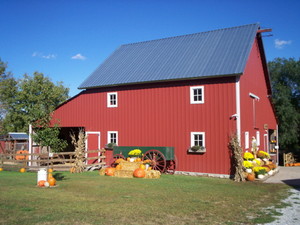
Bloom Where You're Planted Farm
15 Jul Wed 2009
Pumpkins & Pollinators
It has been almost seven weeks since we first started planting this year's pumpkin crop. The average pumpkin takes 90-100 days to grow, so this means we are approaching the half-way point for many of the varieties.
The plants are looking pretty good, thanks to our regular rains and minimal amount of hot, windy days. Pumpkins can handle a lot of heat, but hot wind is very tough on them. We've had our usual bug problems, and plenty of weeds to deal with (they've enjoyed the rain, too!) but it could be much worse. Overall, we're pleased and grateful for the growth we can see every time we visit the fields.
We're also very grateful to see lots and lots of bees, as we rely on them to pollinate the flowers. Many of the flowers I looked at this morning had two or more bees apiece! Did you know there is a type of bee called the "Squash Bee"? These make up the majority of our pollinators. Here is some information about squash bees from Auburn University's website: "Unlike honey bees, squash bees do not live in social colonies. Each female digs her own vertical tunnel in the ground, usually near the host plants, and spends the morning gathering nectar and pollen to feed her offspring. A squash bee's foraging activity is highly synchronized with the host plants' bloom: the bee emerges from her burrow near dawn as the flowers open, quickly gathers pollen and nectar, and ceases foraging by late morning when the flowers close. Males, in contrast, patrol host flowers all morning looking for unmated females, then crawl into a wilting flower to pass the afternoon and night."
Fascinating, isn't it??

